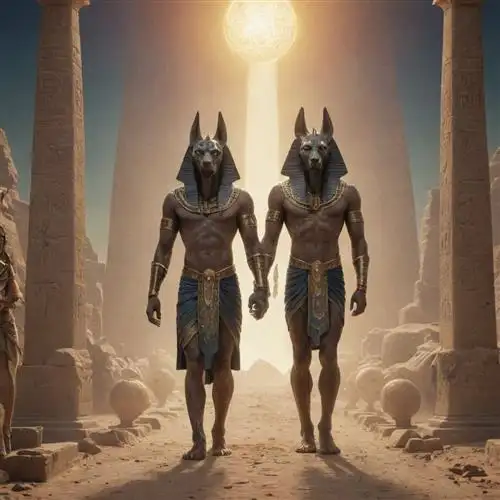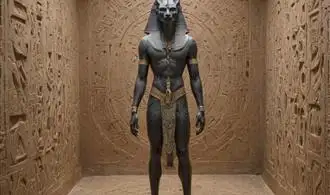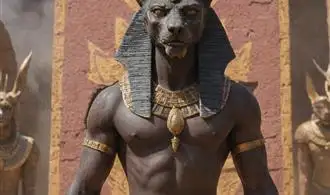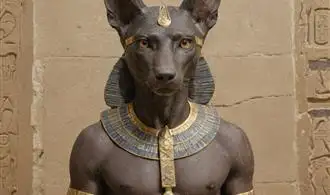
The Enigmatic Deity Anubis
Anubis, the jackal-headed deity, has long been a subject of fascination for those captivated by the mysteries of ancient Egyptian mythology. As the god associated with the afterlife, Anubis played a pivotal role in the rituals and beliefs surrounding death and the journey to the next world. Delving into the depths of this enigmatic figure reveals a multifaceted and complex deity with a profound influence on the ancient Egyptian psyche.
At the core of Anubis's significance lies his role as the guardian of the dead. As the one who presided over the embalming process, Anubis was responsible for the crucial task of ensuring the deceased's successful transition to the afterlife. This duty was not merely a practical one but held deep symbolic meaning, as Anubis's presence was seen as essential in guiding the soul through the perilous journey of the underworld.
The iconography of Anubis, with his distinctive jackal-like head, is both captivating and laden with symbolism. The jackal, a creature associated with the desert and the borderlands between the living and the dead, was chosen to represent Anubis, reflecting his role as the intermediary between these two realms. Additionally, the black color of Anubis's skin was believed to symbolize the process of mummification and the regenerative power of the earth.
Anubis's prominence in the Egyptian pantheon is evidenced by his presence in numerous important rituals and funerary practices. One of the most significant was the "weighing of the heart" ceremony, in which the deceased's heart was weighed against the feather of truth, with Anubis overseeing the process. This ritual, which determined the fate of the soul, underscores the crucial role Anubis played in the ancient Egyptian conception of the afterlife.
Beyond his association with the afterlife, Anubis was also revered as a deity of protection, healing, and guidance. In this capacity, he was invoked by the living to help them navigate the challenges and uncertainties of the mortal realm. The cult of Anubis, which spanned various regions of ancient Egypt, attests to the widespread reverence and veneration afforded to this enigmatic deity.
The Journey to the Afterlife
The Journey to the Afterlife with Anubis, the Jackal-Headed God, is a captivating and intricate aspect of ancient Egyptian mythology. Anubis, the guardian of the dead, played a crucial role in the complex rituals and beliefs surrounding the afterlife. As the protector of the deceased, Anubis guided the souls of the dead through the treacherous journey to the afterlife, ensuring their safe passage and ultimate judgment before the divine court.
At the heart of this journey lies the concept of the weighing of the heart, a pivotal moment in the afterlife process. The deceased would undergo a meticulous examination, where their heart was weighed against the feather of truth, symbolizing the balance between their earthly deeds and the standards of the divine. Anubis, with his keen eye and unwavering dedication, would preside over this solemn ceremony, ensuring the accuracy and fairness of the judgment.
The preparation for this journey was equally significant. The process of mummification, meticulously carried out under the watchful gaze of Anubis, was designed to preserve the physical body and prepare the soul for its transition to the afterlife. The intricate rituals, the careful wrapping of the body, and the placement of sacred amulets and talismans were all orchestrated to ensure the deceased's safe passage and the protection of their soul.
But the journey did not end there. Anubis, the psychopomp, the guide of souls, would then lead the deceased through the treacherous underworld, navigating the labyrinth of passages and guardians. This treacherous path was fraught with challenges and dangers, testing the deceased's adherence to the principles of righteousness and their readiness to face the ultimate judgment.
Throughout this journey, Anubis stood as the steadfast companion, offering guidance, protection, and the assurance of a safe arrival. His presence was a beacon of hope, a symbol of the divine's unwavering commitment to the well-being of the deceased. Discover the Fascinating History of Anubis Artwork to further explore the rich artistic and cultural representations of this enigmatic deity.
Anubis and the Mummification Process
The role of Anubis in the mummification process was integral to the ancient Egyptians' beliefs about the afterlife. As the god of embalming and the protector of the dead, Anubis oversaw the complex rituals that transformed the physical body into a vessel for the soul's eternal journey.
At the heart of the mummification process was the belief that the body needed to be preserved in order for the soul, or ka, to return to it after death. Anubis was responsible for guiding the deceased through the intricate steps of this transformation, ensuring that the body was properly prepared and protected.
The mummification process involved a series of meticulous procedures, including the removal of the internal organs, the drying of the body using natron, and the wrapping of the body in linen bandages. Anubis was present at each stage, offering guidance and protection to the deceased.
One of the most significant roles of Anubis was the ritual of the "Opening of the Mouth," in which the god would use a special tool to symbolically restore the deceased's ability to see, hear, and speak in the afterlife. This ceremony was crucial, as it was believed to reawaken the senses and allow the soul to fully inhabit the mummified body.
In addition to his role in the mummification process, Anubis was also responsible for weighing the heart of the deceased against the feather of truth, a ritual known as the "Weighing of the Heart." This judgment determined whether the soul would be allowed to pass into the afterlife or be condemned to eternal torment.
The Weighing of the Heart Ceremony
The Weighing of the Heart Ceremony was a pivotal ritual in ancient Egyptian beliefs about the afterlife. This ceremony was central to the journey of the deceased, as it determined whether their soul would be granted eternal peace or condemned to eternal torment. The process was overseen by the jackal-headed god Anubis, who was responsible for guiding the dead through the underworld and ensuring the fairness of the judgment.
At the heart of the ceremony was the weighing of the individual's heart against the feather of Ma'at, the goddess of truth and justice. The heart was believed to be the seat of the individual's soul, and it was this organ that would be weighed to determine the person's moral standing. If the heart was found to be lighter than the feather, it signified a life lived in accordance with the principles of Ma'at, and the soul would be granted passage to the afterlife. However, if the heart was heavier, it indicated a life filled with sin and wrongdoing, and the soul would be condemned to be devoured by the fearsome devourer, a creature with the head of a crocodile, the front legs of a lion, and the hindquarters of a hippopotamus.
The ceremony itself was a solemn and sacred affair, with the deceased's heart placed on one side of a scale and the feather of Ma'at on the other. Anubis, in his role as the god of the dead, would carefully observe the proceedings, ensuring that the judgment was fair and impartial. If the heart was deemed worthy, the deceased would be granted passage to the Field of Reeds, a paradise-like realm where they would enjoy an eternity of peace and prosperity. However, if the heart was deemed unworthy, the soul would be condemned to a fate worse than death, doomed to wander the underworld for eternity or to be devoured by the devourer.
Anubis in Modern Interpretations and Pop Culture
Anubis, the ancient Egyptian god of the afterlife, has captivated the imagination of modern audiences for centuries. From its iconic depiction in ancient artwork to its enduring presence in popular culture, this enigmatic deity continues to fascinate and intrigue. In the realm of modern interpretations and pop culture, Anubis has found a resurgence of interest, transcending its historical roots and evolving into a symbol of both reverence and artistic expression.
One of the most notable aspects of Anubis' modern portrayal is its integration into various forms of media and entertainment. In the realm of cinema, the god has been featured in numerous blockbuster films, often serving as a focal point for narratives exploring the mysteries of the afterlife. From the iconic appearance of Anubis in the "Mummy" franchise to its more subtle references in other acclaimed productions, the god's cinematic representation has captivated audiences, sparking a renewed interest in ancient Egyptian mythology.
Beyond the silver screen, Anubis has also found a prominent place in the world of comic books and graphic novels. Artists and writers have embraced the rich symbolism and visual appeal of the jackal-headed deity, incorporating it into complex narratives that delve into themes of death, rebirth, and the secrets of the underworld. These modern interpretations have not only brought Anubis to a new generation of fans but have also explored the deeper philosophical and spiritual significance of the god's role in ancient Egyptian beliefs.
In the realm of literature, Anubis has also found a prominent place, with authors weaving the god's mythology into their narratives. From historical fiction that reimagines ancient Egypt to contemporary fantasy works that blend modern elements with ancient motifs, Anubis has become a recurring figure that captivates readers and sparks their curiosity about the mysteries of the afterlife.
The presence of Anubis in modern popular culture extends beyond the realms of film, comics, and literature. The god has also become a symbol of artistic expression, with visual artists, tattoo designers, and even fashion designers incorporating Anubis' iconic imagery into their creations. These interpretations not only celebrate the god's enduring legacy but also explore the ways in which ancient Egyptian mythology can be reinterpreted and reimagined for contemporary audiences.
















